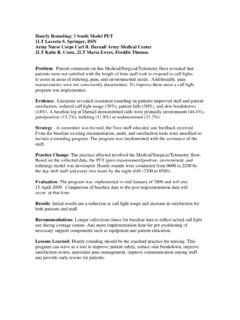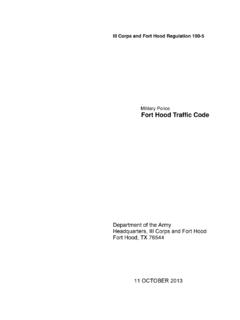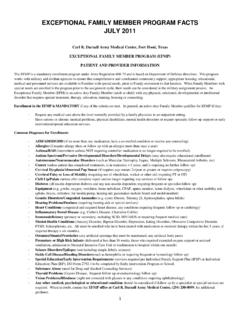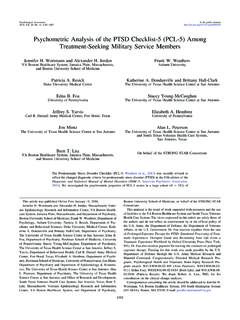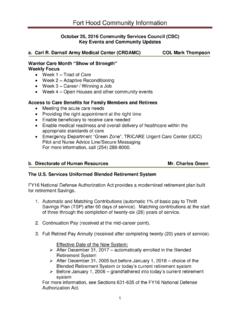Transcription of Screening for Depression - Home | American Academy of ...
1 January 15, 2012 Volume 85, Number 2 American Family Physician 139 Screening for DepressionDOUGLAS M. MAURER, DO, MPH, carl . R. Darnall army Medical Center, Fort Hood, Texas Despite a multitude of treatments, Depression has an estimated prevalence of to percent in the general population,1 and affects 5 to 13 percent of patients in pri-mary care The condition accounts for more than $43 billion in medical care costs and $17 billion in lost productiv-it y a n nua l Depression is projected to become the second largest cause of disability by is often not adequately Even when treated appropriately, more than 75 percent of patients with Depression have recurrent episodes and 10 to 30 per-cent have residual ,7 Depression has been associated with poorer outcomes in patients with a variety of medical con-ditions.
2 Such as coronary artery disease, diabetes mellitus, and Treatment of Depression may reduce mortality from these conditions, as well as help prevent Therefore, accurately identify-ing patients who have Depression is impor-tant so that appropriate treatment can be initiated. Symptoms and Risk Factors Classically, patients with Depression present with psychological symptoms of depressed mood, loss of interest in activities, impaired concentration, feelings of worthlessness or guilt, and suicidal ideation. However, some patients may instead report nonspecific symptoms (Ta b l e 1) . One study found that 45 to 95 percent of patients with Depression worldwide have only somatic underlying cause of Depression is likely multifactorial.
3 Risk factors (Ta b l e 2) should be considered when evaluating patients with possible for DepressionA 2005 Cochrane review found that routine Depression Screening had minimal effect on the management or outcomes of depres-sion after six or 12 months of However, the Preventive Services Task In the United States, Depression affects up to 9 percent of patients and accounts for more than $43 billion in medical care costs. The Preventive Services Task Force recommends screen-ing in adolescents and adults in clinical practices that have systems in place to ensure accurate diagnosis, effective treatment, and follow-up. It does not recommend for or against Screening for Depression in children seven to 11 years of age or Screening for suicide risk in the general population.
4 The Patient Health Questionnaire (PHQ)-2 and PHQ-9 are commonly used and validated Screening tools. The PHQ-2 has a 97 percent sensitivity and 67 percent specificity in adults, whereas the PHQ-9 has a 61 percent sensitivity and 94 percent specificity in adults. If the PHQ-2 is positive for Depression , the PHQ-9 should be administered; in older adults, the 15-item Geriatric Depression Scale is also an appropriate follow-up test. If these Screening tests are positive for Depression , further evaluation is needed to confirm that the patient s symptoms meet the Diagnostic and Statistical Manual of Mental Disorders criteria for diagnosis. (Am Fam Physician. 2012;85(2):139-144. Copyright 2011 American Academy of Family Physicians.) Patient information: A handout on this topic is available at http://family 1.
5 Nonspecific Symptoms of DepressionAbdominal painBack painChange in weight or appetiteConstipationFatigueHeadacheInsom nia or hypersomniaJoint painNeck painWeaknessDownloaded from the American Family Physician Web site at Copyright 2012 American Academy of Family Physicians. For the private, noncom-mercial use of one individual user of the Web site. All other rights reserved. Contact for copyright questions and/or permission Screening140 American Family Physician Volume 85, Number 2 January 15, 2012 Force (USPSTF) has published more recent reviews on Depression Screening . This arti-cle focuses on the recommendations and findings of the USPSTF found good evidence that treat-ment with antidepressants, psychotherapy, or both decreases clinical morbidity and improves outcomes in adults with depres-sion identified through Screening in primary care settings.
6 Screening adults for depres-sion is recommended in clinical practices that have systems in place to ensure accurate diagnosis, effective treatment, and follow-up. Screening for Depression in clinical prac-tices without these systems is of minimal benefit. Furthermore, the USPSTF found no evidence of harms of Screening for depres-sion in USPSTF found insufficient evidence to recommend for or against Screening for suicide risk in the general population, compared with Screening only those with AND CHILDRENThe USPSTF recommends Screening adoles-cents 12 to 18 years of age for Depression in clinical practices that have systems (or refer-ral systems) in place to ensure accurate diag-nosis, psychotherapy (cognitive behavioral or interpersonal therapy), and follow-up.
7 There is insufficient evidence to balance the benefits and harms of Depression Screening in children seven to 11 years of age. There is adequate evidence that treatment with selective serotonin reuptake inhibitors, psy-chotherapy, or both decreases Depression symptoms in adolescents. Similar evidence is lacking in INSTRUMENTSMany instruments have been developed for Depression Screening . Although the USPSTF found little evidence that one is superior, the most practical tool for the clinical set-ting should be ,18 Positive results on a Screening test should trigger full diagnostic interviews that use standard diagnostic crite-ria from the Diagnostic and Statistical Man-ual of Mental Disorders, 4th ed. (DSM-IV).PHQ-2. Ultrashort Screening instruments, such as the Patient Health Questionnaire (PHQ) -2 (Table 3) may rule out, but not SORT.
8 KEY RECOMMENDATIONS FOR PRACTICEC linical recommendationEvidence ratingReferencesBecause there is no significant difference in performance among the different Depression Screening instruments, the most practical tool for the clinical setting should be , 18 Adults and adolescents 12 to 18 years of age should be screened for Depression in clinical practices that have systems to ensure effective diagnosis, treatment, and , 18 There is insufficient evidence to balance the benefits and harms of Screening children seven to 11 years of age for is insufficient evidence to recommend for or against Screening for suicide risk in the general PHQ-2 is accurate for Depression Screening in adolescents, adults, and older , 20-22, 25 The PHQ-9 is a valid, quick Screening instrument for Depression that also can be used as a follow-up to a positive PHQ-2 result and to monitor treatment Screening in older adults can be accomplished with multiple instruments, including the PHQ-2, PHQ-9, and various Geriatric Depression , 24-26 PHQ = Patient Health = consistent, good-quality patient-oriented evidence; B = inconsistent or limited-quality patient-oriented evidence; C = consensus, disease-oriented evidence, usual practice, expert opinion, or case series.
9 For information about the SORT evidence rating system, go to 2. Risk Factors for DepressionChronic medical illnessChronic minor daily stressChronic pain syndromeFamily history of depressionFemale sexLow income/job lossLow self-esteemLow social supportPrior depressionSingle/divorced/widowedTraumat ic brain injuryYounger ageDepression ScreeningJanuary 15, 2012 Volume 85, Number 2 American Family Physician 141definitively diagnose, However, the PHQ-2, which asks two simple questions about mood and anhedonia, has strengths. It is as effective as longer Screening instru-ments, such as the Beck Depression Inven-tory or Zung Depression ,20,21 The PHQ-2 has been found to be up to 97 percent sensitive and 67 percent specific in adults, with a 38 percent positive predictive value and 93 percent negative predictive It is reported to have a 74 percent sensitivity and 75 percent specificity in The PHQ-9 (Ta b l e 4) is one of the most common instruments used for depres-sion Screening .
10 Although it can be used on its own as a Screening test or to monitor treatment, it is increasingly administered for confirmation of a positive PHQ-2 result. The PHQ-9 is valid, takes two to five min-utes to complete, and has demonstrated Table 3. Patient Health Questionnaire-2: Screening Instrument for DepressionOver the past two weeks, how often have you been bothered by any of the following problems?Not at allSeveral daysMore than one-half the daysNearly every dayLittle interest or pleasure in doing things0123 Feeling down, depressed, or hopeless0123 NOTE: If the patient has a positive response to either question, consider administering the Patient Health Questionnaire-9 or asking the patient more questions about possible Depression . For older adults, consider the Patient Health Questionnaire-9 or the 15-item Geriatric Depression Scale.













